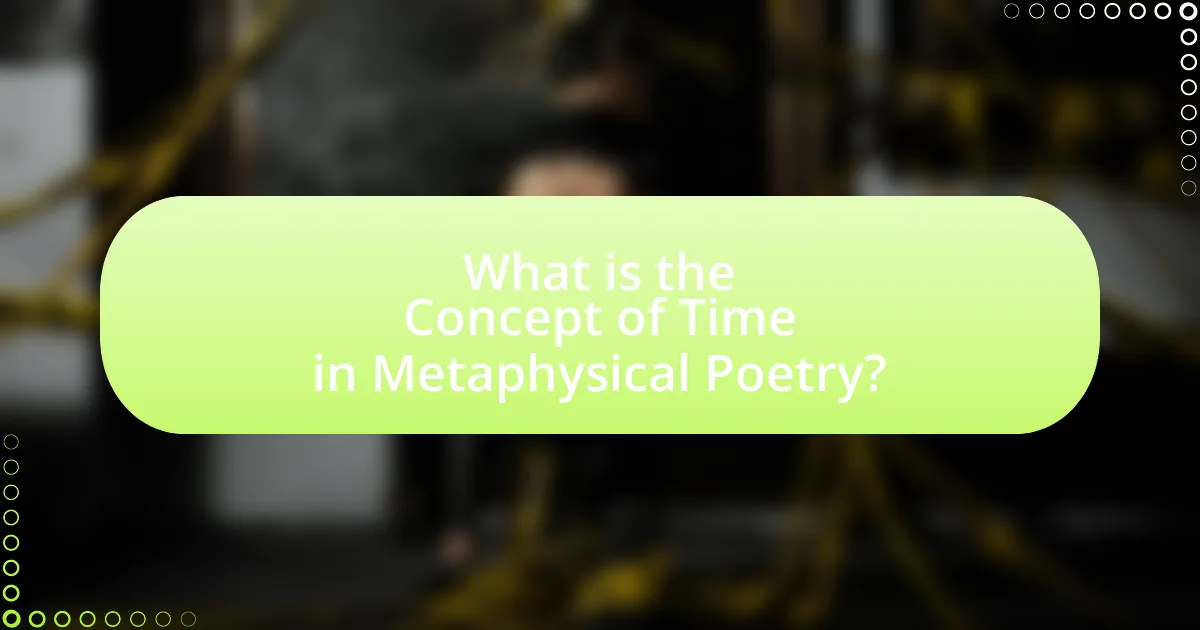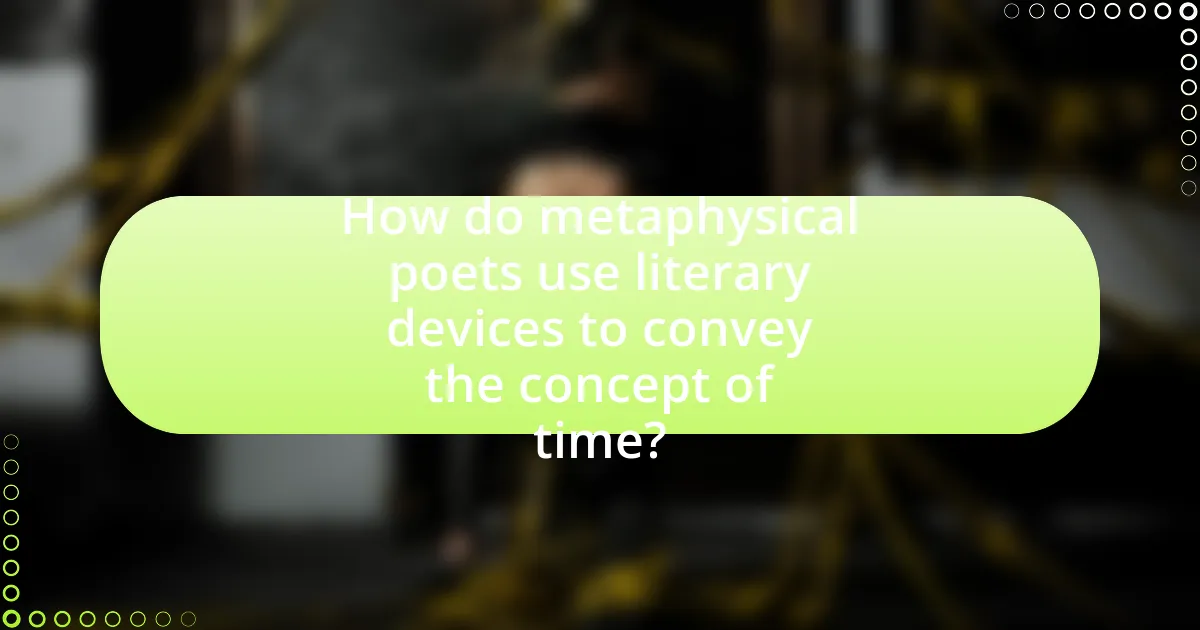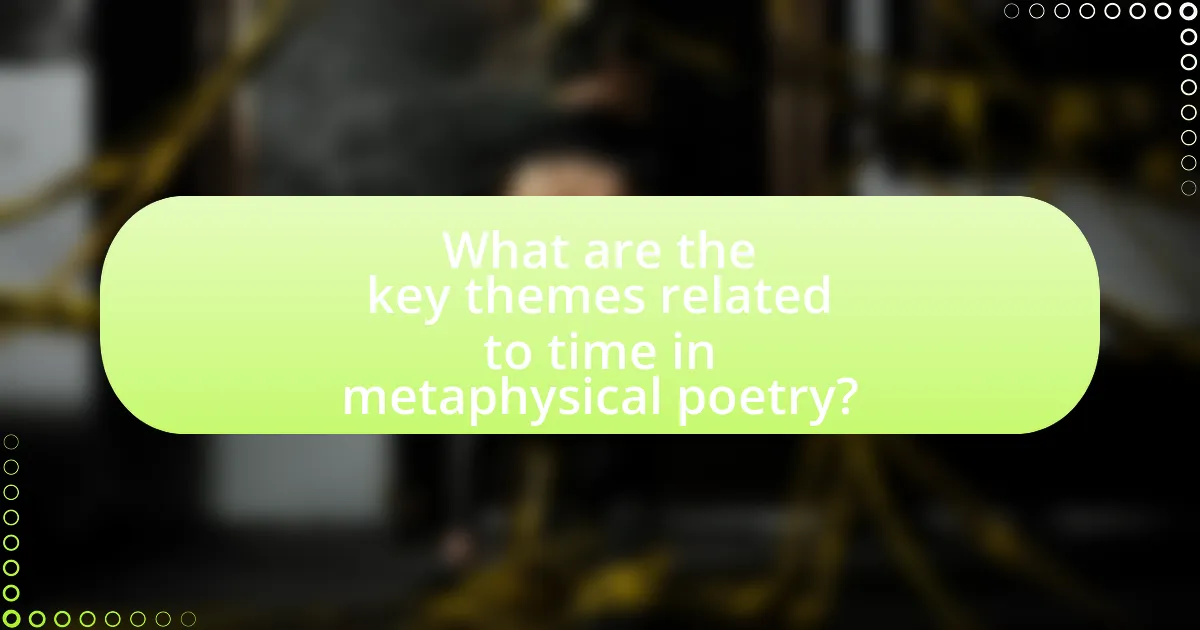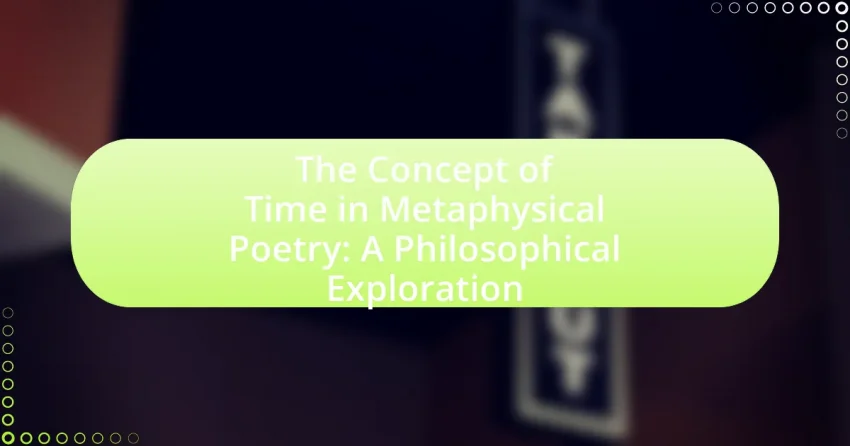The article examines the concept of time in metaphysical poetry, focusing on how poets like John Donne and Andrew Marvell portray time as a complex and multifaceted theme that intertwines with love, mortality, and existence. It explores how metaphysical poets define time, presenting various philosophical perspectives that emphasize its relativity and transience. Key themes include the interplay between the eternal and the temporal, the significance of mortality, and the emotional depth that time adds to human experiences. The article also discusses the literary devices used to convey these concepts and the historical context that shapes the poets’ views on time.

What is the Concept of Time in Metaphysical Poetry?
The concept of time in metaphysical poetry is often portrayed as a complex and multifaceted theme that challenges conventional perceptions. Metaphysical poets, such as John Donne and Andrew Marvell, explore time not merely as a linear progression but as a dynamic force that intertwines with love, mortality, and existence. For instance, in Donne’s “The Sun Rising,” time is depicted as a construct that can be transcended through love, suggesting that emotional connections can defy temporal limitations. This perspective is reinforced by the use of paradox and wit, common in metaphysical poetry, which emphasizes the tension between the ephemeral nature of life and the enduring power of human relationships.
How do metaphysical poets define time in their works?
Metaphysical poets define time as a complex and often paradoxical concept that intertwines physical reality with spiritual and emotional experiences. In their works, such as John Donne’s “The Good Morrow,” time is portrayed as both a linear progression and a cyclical phenomenon, emphasizing the transient nature of human existence while also exploring the eternal aspects of love and the soul. This duality reflects the poets’ philosophical inquiries into the nature of reality, where time serves as a backdrop for existential contemplation and the search for meaning.
What philosophical perspectives on time are presented in metaphysical poetry?
Metaphysical poetry presents various philosophical perspectives on time, primarily exploring its relativity, transience, and the interplay between the eternal and the temporal. Poets like John Donne and Andrew Marvell often depict time as a fluid construct, emphasizing its ability to alter human experience and perception. For instance, Donne’s poem “The Sun Rising” illustrates time’s subjective nature by challenging the authority of the sun and conventional timekeeping, suggesting that love transcends temporal boundaries. Similarly, Marvell’s “To His Coy Mistress” reflects on the urgency of seizing the moment, highlighting the fleeting nature of life and the inevitability of death. These perspectives underscore a complex understanding of time, where it is both a physical reality and a philosophical concept that shapes human existence and relationships.
How does the perception of time influence the themes in metaphysical poetry?
The perception of time significantly influences the themes in metaphysical poetry by shaping the exploration of love, mortality, and the nature of existence. Metaphysical poets, such as John Donne and Andrew Marvell, often juxtapose the transient nature of time with the eternal aspects of human experience, creating a tension that deepens their thematic concerns. For instance, in Donne’s “The Good Morrow,” the speaker reflects on the idea that true love transcends time, suggesting that emotional connections can defy temporal limitations. This interplay between time and love illustrates how metaphysical poetry often grapples with the fleeting nature of life while simultaneously seeking permanence in relationships and spiritual truths. The use of complex metaphors and philosophical inquiries further emphasizes the poets’ engagement with time as a central theme, reinforcing the notion that understanding time is crucial to comprehending the human condition.
Why is the exploration of time significant in metaphysical poetry?
The exploration of time is significant in metaphysical poetry because it allows poets to delve into complex philosophical questions about existence, mortality, and the nature of reality. Metaphysical poets, such as John Donne and Andrew Marvell, often use time as a framework to examine the transient nature of life and the eternal aspects of love and spirituality. For instance, Donne’s poem “The Sun Rising” reflects on the relationship between time and love, suggesting that love transcends temporal boundaries. This exploration is further validated by the use of intricate metaphors and arguments that challenge conventional perceptions of time, emphasizing its fluidity and the human experience of it. Thus, the significance lies in how metaphysical poetry uses time to provoke deeper contemplation about life’s ultimate truths.
What role does time play in the relationship between the self and the universe?
Time serves as a fundamental framework that shapes the relationship between the self and the universe by influencing perception, existence, and interconnectedness. The self experiences time linearly, which creates a sense of individuality and temporality, while the universe operates on a broader, often cyclical or non-linear timeline, suggesting a deeper, interconnected reality. This duality highlights how individual experiences are transient yet part of a larger cosmic order, as seen in metaphysical poetry where poets like John Donne explore themes of time to illustrate the unity of the self with the universe. For instance, Donne’s poem “A Valediction: Forbidding Mourning” emphasizes the enduring connection between lovers despite physical separation, illustrating how time can both separate and unite. Thus, time acts as both a boundary and a bridge, shaping the self’s understanding of its place within the vast universe.
How does the concept of time affect the emotional depth of metaphysical poetry?
The concept of time significantly enhances the emotional depth of metaphysical poetry by allowing poets to explore complex themes of existence, mortality, and the transient nature of human experience. Metaphysical poets, such as John Donne and Andrew Marvell, often juxtapose the fleeting nature of time with profound emotional states, creating a tension that deepens the reader’s engagement. For instance, in Donne’s “The Sun Rising,” the speaker challenges the passage of time by asserting the power of love to transcend temporal limitations, illustrating how love can provide a sense of permanence amidst the inevitable decay of time. This interplay between time and emotion invites readers to reflect on their own experiences, thereby enriching the overall impact of the poetry.

How do metaphysical poets use literary devices to convey the concept of time?
Metaphysical poets utilize literary devices such as metaphors, similes, and paradoxes to convey the concept of time. For instance, John Donne often employs metaphors that juxtapose love and time, illustrating how love transcends temporal boundaries. In “The Good Morrow,” he suggests that true love creates a timeless existence, contrasting the fleeting nature of physical life. Additionally, paradoxes in poems like Andrew Marvell’s “To His Coy Mistress” highlight the tension between the desire for eternal love and the reality of time’s passage, emphasizing urgency and the ephemeral nature of life. These devices effectively communicate the complex relationship between human experience and the relentless flow of time.
What specific literary techniques are employed to depict time?
Literary techniques employed to depict time include flashbacks, foreshadowing, and non-linear narrative structures. Flashbacks allow authors to present past events, creating a layered understanding of characters and themes, as seen in John Donne’s poetry where past experiences inform present emotions. Foreshadowing hints at future events, building anticipation and tension, which can be observed in Andrew Marvell’s works where the passage of time influences the urgency of love. Non-linear narratives disrupt chronological order, reflecting the complexity of time, a technique effectively utilized by poets like George Herbert, who intertwines past and present to explore existential themes. These techniques collectively enhance the reader’s perception of time, making it a central element in metaphysical poetry.
How do metaphors and similes enhance the understanding of time in these poems?
Metaphors and similes enhance the understanding of time in these poems by providing vivid imagery that conveys complex temporal concepts. For instance, when time is described as a “fleeting shadow,” it illustrates the transient nature of existence, allowing readers to grasp the ephemeral quality of life. Similarly, a simile comparing time to a “river flowing endlessly” emphasizes continuity and the inevitability of change, reinforcing the philosophical notion that time is both linear and cyclical. These figurative language tools create emotional resonance and deepen the reader’s engagement with the theme of time, making abstract ideas more tangible and relatable.
What is the impact of structure and form on the representation of time?
The impact of structure and form on the representation of time is significant, as they dictate how temporal elements are perceived and experienced within a poem. In metaphysical poetry, the use of varied stanza lengths, enjambment, and rhyme schemes can manipulate the reader’s sense of time, creating a fluid or fragmented experience. For instance, John Donne’s “The Good Morrow” employs a structured form that contrasts with the theme of eternal love, suggesting a timeless quality despite the poem’s temporal setting. This interplay between form and content allows poets to explore complex ideas about time, such as its linearity or cyclical nature, ultimately shaping the reader’s understanding of temporal concepts.
How does the historical context influence the portrayal of time in metaphysical poetry?
The historical context significantly influences the portrayal of time in metaphysical poetry by reflecting the philosophical and scientific shifts of the 17th century. During this period, the rise of rationalism and the scientific revolution prompted poets like John Donne and George Herbert to explore complex ideas about existence, mortality, and the nature of time. For instance, the tension between the transient nature of human life and the eternal aspects of divine time is a recurring theme, illustrating how poets grappled with the implications of new scientific understandings of the universe. This interplay is evident in works such as Donne’s “A Valediction: Forbidding Mourning,” where the concept of time is both a physical and metaphysical construct, shaped by the era’s evolving worldview.
What philosophical movements of the time shaped the poets’ views on time?
The philosophical movements of the time that shaped poets’ views on time include Neoplatonism and Stoicism. Neoplatonism emphasized the idea of an eternal realm beyond the physical world, influencing poets to perceive time as a fleeting aspect of a greater, unchanging reality. Stoicism, on the other hand, taught the importance of accepting the present moment and understanding the transient nature of life, which led poets to reflect on the impermanence of time and the necessity of living in accordance with nature. These movements provided a framework for metaphysical poets to explore complex themes of time, existence, and the human experience.
How do societal changes reflect in the metaphysical understanding of time?
Societal changes significantly influence the metaphysical understanding of time by altering perceptions of temporality and existence. For instance, the transition from agrarian societies to industrialized ones shifted the focus from cyclical, nature-based time to linear, progress-oriented time. This shift is evident in metaphysical poetry, where poets like John Donne and Andrew Marvell explore themes of mortality and the fleeting nature of life, reflecting societal anxieties about time in a rapidly changing world. Historical events, such as the Enlightenment and the Industrial Revolution, prompted a reevaluation of time as a measurable entity, leading to a more fragmented and individualistic understanding of existence. This evolution in thought illustrates how societal transformations can reshape metaphysical concepts, emphasizing the relationship between cultural context and philosophical inquiry into time.

What are the key themes related to time in metaphysical poetry?
Key themes related to time in metaphysical poetry include the transient nature of life, the interplay between eternity and mortality, and the exploration of time as a philosophical construct. Metaphysical poets, such as John Donne and Andrew Marvell, often reflect on how time affects human experience, emphasizing its fleeting quality and the inevitability of death. For instance, in Donne’s “The Sun Rising,” time is portrayed as a force that can be challenged by love, suggesting that emotional connections can transcend temporal limitations. Additionally, Marvell’s “To His Coy Mistress” illustrates the urgency of seizing the moment, highlighting the tension between desire and the constraints of time. These themes reveal a complex understanding of time, where it is both a physical reality and a metaphysical concept that shapes human existence.
How do metaphysical poets explore the relationship between time and love?
Metaphysical poets explore the relationship between time and love by depicting love as both transcendent and temporal, emphasizing its enduring nature despite the inevitable passage of time. For instance, John Donne’s poem “The Good Morrow” illustrates how love can create a timeless space, suggesting that true love transcends the constraints of time. Similarly, Andrew Marvell’s “To His Coy Mistress” presents a tension between the fleeting nature of life and the desire to seize love in the present, arguing that love should be cherished despite its temporal limitations. These poets utilize complex metaphors and philosophical arguments to convey that while time may alter physical existence, the emotional and spiritual dimensions of love can remain constant and profound.
What insights do poets provide about the transient nature of love through time?
Poets provide profound insights into the transient nature of love through the exploration of its impermanence and the inevitability of change. For instance, John Donne’s poem “The Good Morrow” reflects on the fleeting moments of love, emphasizing how love evolves and transforms over time. Similarly, Andrew Marvell’s “To His Coy Mistress” illustrates the urgency of love in the face of time’s relentless passage, suggesting that love must be cherished in the present due to its ephemeral quality. These works highlight the philosophical understanding that love, while deeply felt, is subject to the constraints of time, ultimately reminding readers of its temporary yet impactful nature.
How does the concept of eternity contrast with temporal experiences in their works?
The concept of eternity in metaphysical poetry often serves as a stark contrast to temporal experiences, highlighting the permanence of existence against the fleeting nature of human life. Poets like John Donne and George Herbert explore eternity as an unchanging state, representing divine truth and spiritual fulfillment, while temporal experiences are depicted as transient, filled with uncertainty and change. For instance, Donne’s “A Valediction: Forbidding Mourning” illustrates the enduring bond of love that transcends time, emphasizing that true connection persists beyond physical separation. In contrast, temporal experiences are characterized by the inevitability of decay and loss, as seen in Herbert’s “The Collar,” where the speaker grapples with the limitations of earthly existence. This juxtaposition underscores the metaphysical exploration of time, revealing how eternity offers a sense of stability and meaning amidst the chaos of temporal life.
What is the significance of mortality in the context of time in metaphysical poetry?
Mortality in metaphysical poetry serves as a crucial lens through which the transient nature of time is examined. This exploration highlights the inevitability of death, prompting poets to reflect on the fleeting moments of life and the urgency to find meaning within them. For instance, John Donne’s “Death Be Not Proud” illustrates how the confrontation with mortality challenges the perception of time, suggesting that death is not an end but a transition, thereby altering the relationship between the temporal and the eternal. This interplay emphasizes that understanding mortality enriches the appreciation of time, as it compels individuals to contemplate their existence and legacy within the finite span of life.
How do poets address the inevitability of death in relation to time?
Poets address the inevitability of death in relation to time by exploring themes of transience and the passage of time as a relentless force. For instance, John Donne in his poem “Death Be Not Proud” personifies death, suggesting that it is not to be feared, as time ultimately diminishes its power. Similarly, Andrew Marvell in “To His Coy Mistress” emphasizes the urgency of seizing the moment, highlighting how time’s progression leads to mortality. These works illustrate that poets often reflect on how time serves as a reminder of life’s fleeting nature, prompting a deeper contemplation of existence and the acceptance of death as an integral part of the human experience.
What reflections on life and existence emerge from the exploration of time and mortality?
The exploration of time and mortality reveals profound reflections on the transient nature of life and the inevitability of death. This understanding prompts individuals to appreciate the present moment, recognizing that life is finite and that each experience holds significance. Metaphysical poetry often emphasizes the tension between the eternal and the ephemeral, illustrating how time shapes human existence and consciousness. For instance, John Donne’s poem “Death Be Not Proud” confronts mortality, suggesting that death is not an end but a passage, thereby encouraging a reevaluation of life’s purpose and the pursuit of meaning. Such reflections highlight the importance of living authentically and embracing the fleeting moments that define human experience.
How can readers apply the insights on time from metaphysical poetry to their own lives?
Readers can apply insights on time from metaphysical poetry by reflecting on the transient nature of existence and the importance of living in the present moment. Metaphysical poets, such as John Donne and Andrew Marvell, often explore themes of time’s fluidity and the interplay between the eternal and the temporal, encouraging individuals to appreciate the fleeting moments of life. For instance, Donne’s poem “The Sun Rising” emphasizes the significance of love transcending time, suggesting that personal relationships can provide a sense of permanence amidst life’s impermanence. By internalizing these themes, readers can cultivate mindfulness and prioritize meaningful experiences, ultimately enhancing their emotional well-being and perspective on life.
What practical lessons about time management can be drawn from these poems?
Practical lessons about time management drawn from these poems include the importance of prioritizing meaningful experiences over trivial pursuits and recognizing the transient nature of time. These poems often emphasize that time is finite, urging individuals to focus on what truly matters in life. For instance, the metaphysical poets frequently illustrate the idea that procrastination can lead to missed opportunities, reinforcing the need for timely action. Additionally, the exploration of time in these works highlights the value of reflection and mindfulness, suggesting that being present can enhance productivity and fulfillment.
How can understanding the philosophical aspects of time enhance personal reflection?
Understanding the philosophical aspects of time enhances personal reflection by providing a framework to analyze one’s experiences and existence. Philosophical theories, such as those proposed by Henri Bergson, emphasize the distinction between measurable time and lived time, encouraging individuals to consider how their subjective experiences shape their understanding of life. This perspective allows for deeper introspection, as individuals can evaluate their past decisions, current state, and future aspirations in relation to their personal timeline. By engaging with these philosophical concepts, individuals can cultivate a more nuanced awareness of their identity and purpose, ultimately leading to more meaningful reflections on their life journey.
